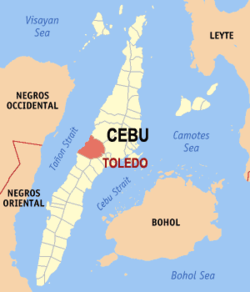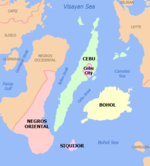Toledo, Cebu
Toledo | |
|---|---|
| City of Toledo | |
 Aerial view of Toledo | |
 Map of Cebu with Toledo highlighted | |
| Country | Philippines |
| Region | Central Visayas (Region VII) |
| Province | Cebu |
| District | 3rd district of Cebu |
| Established Cityhood | 1861 |
| Barangay | 38 (see § Barangays) |
| Government | |
| • Type | Sangguniang Panlungsod |
| • Mayor of Toledo City, Cebu[*] | John Osmeña (Ind) |
| • Vice Mayor of Toledo City, Cebu | Antonio Yapha |
| • City Council | Members |
| Area | |
• Total | 216.28 km2 (83.51 sq mi) |
| Population (2020 census)[3] | |
• Total | 207,314 |
| • Density | 960/km2 (2,500/sq mi) |
| • Voter (2022)[4] | 120,481 |
| • Language | Cebuano Tagalog |
| Time zone | UTC+8 (PST) |
| ZIP code | 6038 |
| IDD : area code | +63 (0)32 |
| Income class | 3rd class |
| PSGC | 072251000 |
| Website | toledocity |
City of Toledo (Cebuano: Dakbayan sa Toledo; Filipino: Lungsod ng Toledo), formerly known as Pueblo Hinulawan is a [[Template:PH plural of the Philippines#Income classification|3rd city income class component city]] in the province of Cebu, Philippines. According to the 2020 census, it has a population of 207,314.[3] Template:PH electorate
Toledo became a chartered city on 18 June 1960 under Republic Act No. 2688.[5]
Toledo is about 50 kilometres (31 mi) away from Cebu City and is widely known for its huge mining industry owned by Atlas Consolidated Mining and Development Corporation, which is the umbrella of Carmen Copper Corporation and its Toledo Mine.[6]
Geography
Barangays
Toledo City comprises 38 barangays:[2]
Demographics
| Year | Pop. | ±% p.a. |
|---|---|---|
| 1990 | 119,970 | — |
| 1995 | 121,469 | +0.23% |
| 2000 | 141,174 | +3.28% |
| 2007 | 152,960 | +1.11% |
| 2010 | 157,078 | +0.97% |
| Source: National Statistics Office[7][8] | ||
History
Toledo City came from Old Hinulawan (now called Daanglungsod) and New Hinulawan.
On June 3, 1863 a series of earthquakes shook Hinulawan. The first tremor toppled the newly built school, leveled several houses to the ground, and caused the church façade to collapse. It caused injuries and fatalities. The quake that followed brought greater damage: complete destruction of the church and the convent; cracking of the lowlands in all directions; crumbling of the stone walls along the Hinulawan river bank; and sagging of the ground, causing water from the sea and the river to flood the settlement to waist level.
A third tremor totally destroyed pueblo Hinulawan. The survivors were rescued by residents of neighboring highland localities.[9]
Those who survived the Hinulawan earthquakes slowly rebuilt their lives in the days that followed. With the help of the people of brgy Tubod, some of the survivors cleared portions of the virgin forest and plateau in the vicinity and constructed houses with roofs made of cogon grass. Those who did not want to live in the new clearings built their homes at the foot of the Tubod highlands. They buried their dead in a cemetery in a certain part of the plateau not far from where they lived. The area occupied by this particular group, a majority of the survivors, subsequently evolved into the New Hinulawan.
A minority of the refugees decided to migrate to other places: the hinterlands of Da-o, Bulok-bulok, Landahan, and Sam-ang as well as the pioneering settlements in the seafronts of Cabito‑onan and Batohanon.
In those days pirate attacks against pueblos situated near the shores of Tañon Strait were rampant. To protect themselves against such attacks, the residents of New Hinulawan built a baluarte, or bulwark, made of chopped stone blocks piled along the shoreline. With the passage of time, however, the bulwark became dilapidated and fell apart, its remnants forever buried in the sand during the construction of the first municipio, or Municipal Hall building. The municipio itself was destroyed by Philippine Commonwealth troops and Cebuano guerrillas in World War II.
Many years later, a few among those who resettled in New Hinulawan decided to return to their former homes in Old Hinulawan when the depressed lowlands gradually became habitable. Old Hinulawan is the present-day Daanglungsod.
The majority who opted to remain in New Hinulawan worked hard to regain the prosperity they had achieved before Old Hinulawan was wiped out by catastrophe.[10]
Pueblo Toledo
Two significant events happened in mid-1869 which led to the change of name of New Hinulawan:
- Carlos María de la Torre (1869-1872) became the new Spanish Governor-general of the Philippines.
- Father Mariano Brazal (1869-1876), who championed the Filipinization of parishes, assumed the duties as parish priest of New Hinulawan, replacing Father Servando Seoane who was transferred to another parish.
Fr. Brazal and the new governor-general were proponents of political liberalism which was on the rise in Spain during that period following the fall of queen Isabel II.
Meanwhile, the alcalde mayor of Cebu (equivalent to the modern-day Cebu Provincial Governor), Esteban Perez, was the childhood friend of governor-general de la Torre in their hometown Toledo, Spain. Perez was married to a Philippine woman and used to spend his vacation with his family in Talavera, a part of New Hinulawan, where he owned a beach resort. He and Fr. Brazal were also good friends.
A welcome banquet was given in the governor-general's palace in Manila[clarification needed] in the evening of July 12, 1869 which was attended by students, priests, and Filipino leaders to express their gratitude to de la Torre's liberal policies.
During that happy occasion de la Torre and Perez had the opportunity to reminisce about their boyhood days in Spain in the presence of Fr. Brazal. In the course of their recollection of the happy past, Perez told the governor-general about New Hinulawan and his special affection for the place because his Filipina wife was a native of Talavera, a barangay of New Hinulawan. He told de la Torre about how similar the environment of New Hinulawan was to their homeland Toledo, Spain and how the winding river of Hinulawan was comparable to Rio Tagus (Tajo) in Spain.
That evening Perez and Fr. Brazal recommended to the governor-general that the name of New Hinulawan be changed to Toledo.
Governor-general de la Torre delightfully approved the recommendation at once. He even announced to all people present in the banquet the promulgation of a decree changing the name of pueblo New Hinulawan in the province of Cebu into pueblo Toledo, the name of his beloved birthplace in Spain.[11]
Second World War
In 1942 the Japanese Imperial forces captured and occupied the town of Toledo.
In 1945 local Filipino forces of the Philippine Commonwealth Army from the 8th, 81st, 82nd, 83rd, 85th and 86th Infantry Division aided by Cebuano guerrilla resistance fighters, battled against the Japanese Imperial forces and liberated the town of Toledo.
Toledo City (1960-present)
Toledo also became a chartered city in June 19, 1960 under Republic Act No. 2688.[5]
Although not as progressive as Cebu's other cities, it is unique in that it is the only city in the province on the western seaboard facing Negros Oriental – and therefore strategically located. (Danao, Mandaue, Lapu-Lapu, Cebu City, Talisay, Naga, and Carcar are on the east. One more city, Bogo City, is in the north, on the eastern side.)
The barangays of Cantabaco and Poog [12] have limestone cliffs that local climbers have developed into popular crags for sport climbing.[13]
Shrine of Saint Pedro Calungsod
Following the canonization of Visayan teen martyr Pedro Calungsod on 21 October 2012, the hilltop parish of Cantabaco became the first shrine and church named after the second Filipino saint.[14]
References
- ^ City of Toledo | (DILG)
- ^ a b "Municipal: Toledo, Cebu". PSGC Interactive. Quezon City, Philippines: Philippine Statistics Authority. Retrieved 8 January 2016.
- ^ a b Census of Population (2020). "Region VII (Central Visayas)". Total Population by Province, City, Municipality and Barangay. Philippine Statistics Authority. Retrieved 8 July 2021.
- ^ "Number of Registered Voters by Sex : 2019 National and Local Elections" (PDF). Commission on Elections. 2019.
- ^ a b Republic Act No. 2688 (18 June 1960), Charter of the City of Toledo
- ^ Carmen Copper Corporation
- ^ Census of Population and Housing (2010). "Region VII (Central Visayas)" (PDF). Total Population by Province, City, Municipality and Barangay. National Statistics Office. Retrieved 29 June 2016.
- ^ Censuses of Population (1903–2007). "Region VII (Central Visayas)". Table 1. Population Enumerated in Various Censuses by Province/Highly Urbanized City: 1903 to 2007. National Statistics Office.
- ^ "Destruction of Old Hinulawan (1863)".
- ^ "New Hinulawan (1863-1869)".
- ^ "New Hinulawan of 1869 Became Pueblo Toledo". Retrieved 2009-06-10.
- ^ http://adrenalineromance.com/2015/04/18/poog-crag-a-brand-new-rock-climbing-destination-in-a-tropical-paradise/
- ^ Adrenaline Romance, Cantabaco
- ^ "Thousands flock to Toledo for first Calungsod feast". 2012-10-22. Retrieved 2012-10-13.



